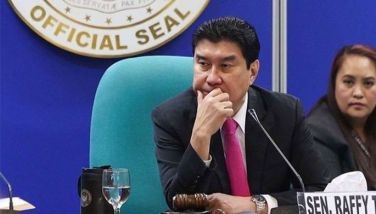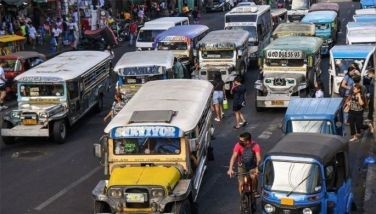We drove through ‘soup’ to Belfast
December 26, 2006 | 12:00am
Last week, we drove all the way to Belfast from Dublin through thick and heavy "soup." That is what they call the fog here in Ireland. That was the same day airline flights were cancelled in Heathrow, London, and in other English airports, too.
When we started out at about past eight in the morning, visibility was down to almost 10 meters. But my son Jun-jun decided to go ahead with the hope that it would soon lift. Actually, we had to pour hot water over the windshield of the car as a thick sheet of ice had covered it.
Later that morning, we discovered a two-mile procession of motorists going to Dublin. But as earlier pointed out, the smooth traffic program assured that cars and other vehicles moved forward in orderly fashion, thereby precluding traffic jams.
Soon, the sun started peeking through the clouds but these were shortlived attempts — at most, five minutes. We moved forward, keenly watching the countryside for signs of farms only to be greeted by spectral sights of ghostlike figures.
We were so engrossed in catching a glimpse of whatever we could see that we overlooked the change from the metric system to the English system. On the Ireland side, they measured distance in terms of kilometers, while at the northern part, which is already UK territory, they measured it by miles.
Arriving in Belfast, we were greeted by great preparations right at the City Hall grounds for one of their biggest Christmas trade fair over the weekend. Workers were rushing to set up kiosks, some of them small cottages.
We would have wanted to enter the City Hall grounds but the ongoing work prevented us from entering, thus we had to content ourselves with pictures outside the massive and very impressive government hall of Belfast.
The clouds lifted a bit while we were at the city center but it was again shortlived and we had trouble looking for the famous Shankill Road.
We finally reached it though and we saw the battleground of the protracted war between the Loyalists and the Republicans. The intensive war was often fought between neighbors. One side of the street blossomed with flags and signs proclaiming loyalty to the English monarch, while the other side of the street had Republican flags proclaiming allegiance to the concept of a free Ireland.
The unique murals of both sides of the struggle remain, reminding all of the intensity of the sectarian political struggle that dated many years ago.
We visited the Sinn Fein headquarters, a prime tourist destination and a source of inspiration to the Irish Republicans.
We introduced ourselves to the lady tending the library and souvenir shop right beside the headquarters and mentioned how many Redemptorist, Columbian and Irish missionaries have served in the Philippines.
Later, she muttered under her breath, "Good Filipino Catholics," whatever that meant.
She also told us that euros are not usually accepted in Belfast, explaining, "We are still being governed by the Queen of England and Prime Minister Blair."
While there was still so much to see in Belfast, we decided to return early because of the fog. Repeatedly, the sun struggled to shine through but only feebly.
We headed back but stopped through Newry, the last town of Northern Ireland before the Republic. Jun-jun decided to buy some groceries and spirits at the Sainsbury as some of the goods there were cheaper than those sold in Dublin.
We saw scores of shoppers, mostly from the Republic side, grabbing drinks by the case. It seemed that most wanted to take advantage of cheaper beer, whisky, wines and cognac from across the border for the holidays.
Driving back to Dublin proved to be nerve-wracking. The fog set in again and we found ourselves joining a long queue of cars. The mist was so heavy that we were so dependent on the taillights of the car before us to guide our way.
It was only when we reached home that we learned about the chaos the fog had brought to the English airports. About 40,000 passengers were stranded not only that day but even days after that.
Belfast is beautiful and worth a visit, even through that soupy weather last Tuesday.
When we started out at about past eight in the morning, visibility was down to almost 10 meters. But my son Jun-jun decided to go ahead with the hope that it would soon lift. Actually, we had to pour hot water over the windshield of the car as a thick sheet of ice had covered it.
Later that morning, we discovered a two-mile procession of motorists going to Dublin. But as earlier pointed out, the smooth traffic program assured that cars and other vehicles moved forward in orderly fashion, thereby precluding traffic jams.
Soon, the sun started peeking through the clouds but these were shortlived attempts — at most, five minutes. We moved forward, keenly watching the countryside for signs of farms only to be greeted by spectral sights of ghostlike figures.
We were so engrossed in catching a glimpse of whatever we could see that we overlooked the change from the metric system to the English system. On the Ireland side, they measured distance in terms of kilometers, while at the northern part, which is already UK territory, they measured it by miles.
Arriving in Belfast, we were greeted by great preparations right at the City Hall grounds for one of their biggest Christmas trade fair over the weekend. Workers were rushing to set up kiosks, some of them small cottages.
We would have wanted to enter the City Hall grounds but the ongoing work prevented us from entering, thus we had to content ourselves with pictures outside the massive and very impressive government hall of Belfast.
The clouds lifted a bit while we were at the city center but it was again shortlived and we had trouble looking for the famous Shankill Road.
We finally reached it though and we saw the battleground of the protracted war between the Loyalists and the Republicans. The intensive war was often fought between neighbors. One side of the street blossomed with flags and signs proclaiming loyalty to the English monarch, while the other side of the street had Republican flags proclaiming allegiance to the concept of a free Ireland.
The unique murals of both sides of the struggle remain, reminding all of the intensity of the sectarian political struggle that dated many years ago.
We visited the Sinn Fein headquarters, a prime tourist destination and a source of inspiration to the Irish Republicans.
We introduced ourselves to the lady tending the library and souvenir shop right beside the headquarters and mentioned how many Redemptorist, Columbian and Irish missionaries have served in the Philippines.
Later, she muttered under her breath, "Good Filipino Catholics," whatever that meant.
She also told us that euros are not usually accepted in Belfast, explaining, "We are still being governed by the Queen of England and Prime Minister Blair."
While there was still so much to see in Belfast, we decided to return early because of the fog. Repeatedly, the sun struggled to shine through but only feebly.
We headed back but stopped through Newry, the last town of Northern Ireland before the Republic. Jun-jun decided to buy some groceries and spirits at the Sainsbury as some of the goods there were cheaper than those sold in Dublin.
We saw scores of shoppers, mostly from the Republic side, grabbing drinks by the case. It seemed that most wanted to take advantage of cheaper beer, whisky, wines and cognac from across the border for the holidays.
Driving back to Dublin proved to be nerve-wracking. The fog set in again and we found ourselves joining a long queue of cars. The mist was so heavy that we were so dependent on the taillights of the car before us to guide our way.
It was only when we reached home that we learned about the chaos the fog had brought to the English airports. About 40,000 passengers were stranded not only that day but even days after that.
Belfast is beautiful and worth a visit, even through that soupy weather last Tuesday.
BrandSpace Articles
<
>
- Latest
- Trending
Trending
Latest
Trending
Latest
Recommended




























